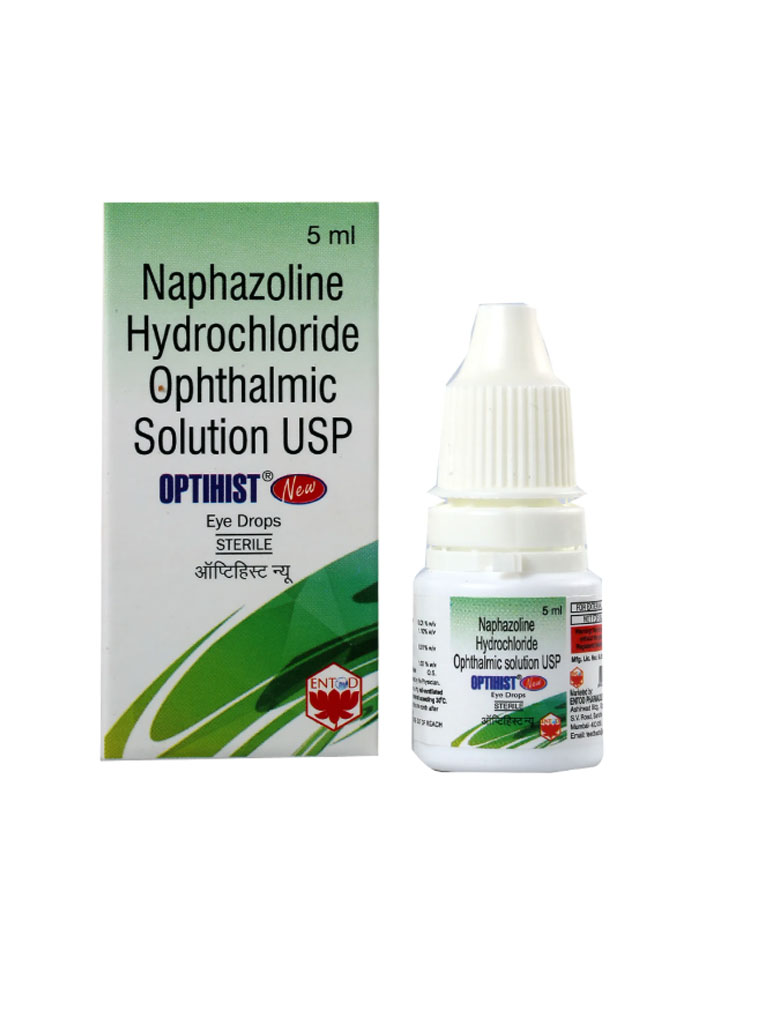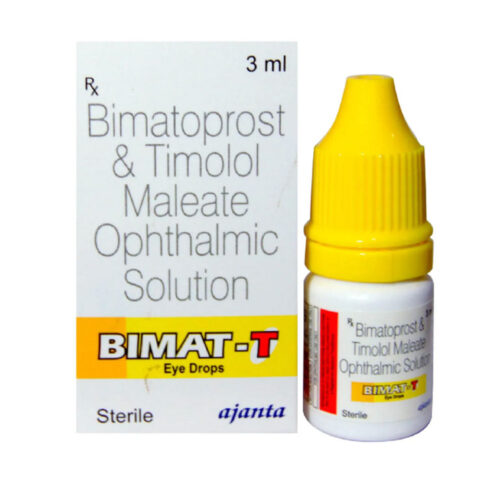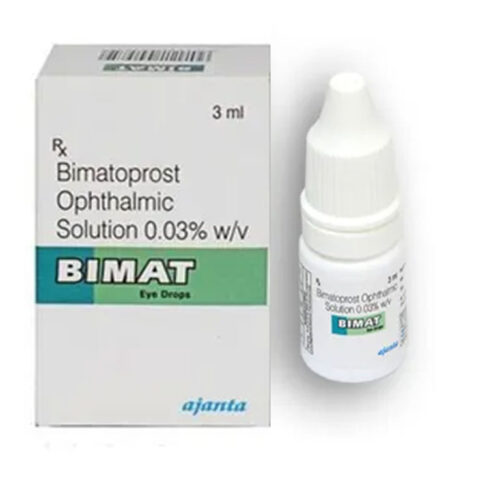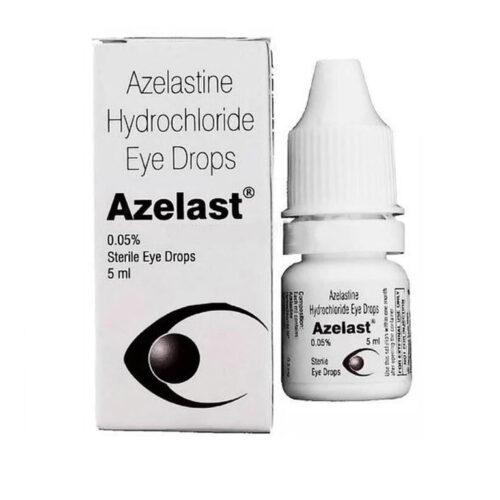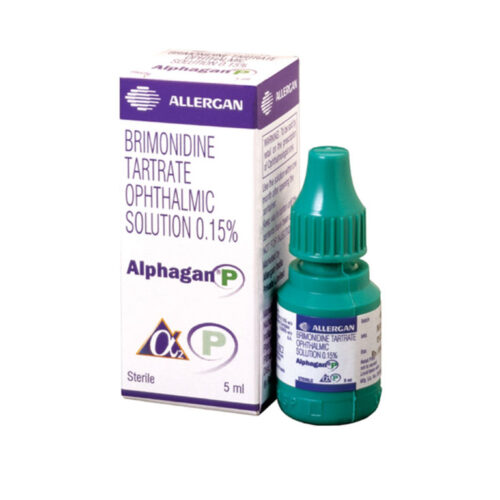Description
What is Optihist® Eye Drops with Naphazoline 0.01% + Boric Acid 1.1%
Optihist® with Naphazoline is a decongestant used to relieve redness, puffiness, and itchy/watering eyes due to colds, allergies, or eye irritations (smog, swimming, or wearing contact lenses). It is known as a sympathomimetic (alpha receptor agonist) that works in the eye to decrease congestion. Some brands of naphazoline eye drop also contain other ingredients. Lubricants (such as glycerin, hypromellose, or polyethylene glycol 300) help protect the eyes from more irritation. Zinc sulfate, boric acid and astringent, helps reduce redness and irritation.
Optihist® Eye Drop helps relieve symptoms of allergic eye disease such as pain, redness, swelling, itching, and watering of eyes. It also reduces infection and irritation in the eye due to its antiseptic property. Use it as prescribed to get the most benefit. If you see no improvement even after a week, talk to your doctor. Apart from using eye drops, it is advisable to wash your eyes with lukewarm water to reduce discomfort.
Optihist® Eye Drops (Naphazoline) is a medicated ophthalmic solution applied to the eyes to treat and relieve redness, itchiness, watering, irritation, and puffiness of the eyes when these symptoms are caused by swimming, contact lenses, allergies, or other causes. The active ingredient in this product is a type of alpha-receptor agonist (sympathomimetic) that decreases congestion in the eyes and reduces redness by narrowing the blood vessels.
Optihist eyedrops are ocular decongestant and lubricating medication. Optihist eyedrops solution contains the active compound naphazoline, a mixed alpha1/alpha2 agonist. It relieves congestion and inflammation, causing rapid narrowing of the blood vessels that results in eye redness resolution.
Optihist eyedrops also contain the active agent boric acid, which has antiseptic and astringent properties.
Optihist eyedrops are used as over-the-counter or prescription medications for many eye conditions. the solution relieves inflammation caused by allergies, irritants, swimming, dry eyes, or contact lens wear.
Optihist eyedrops improve vision quality by promoting transparency of the eye structures. It acts rapidly to clear inflammation and soothe the eyes.
How to use Optihist® Eye Drops with Naphazoline
Follow all directions on the product package, or use as directed by your doctor. If you have any questions, ask your doctor. To apply eye drops, wash your hands first. To avoid contamination, do not touch the dropper tip or let it touch your eye or any other surface. Remove contact lenses before applying the eye drops. Wait at least 10 minutes after using this medication before inserting contact lenses. Before using, check this product visually. Do not use if the liquid has changed color or is cloudy. Use in the affected eye(s) as directed.
Tilt your head back, look upward, and pull down the lower eyelid to make a pouch. Hold the dropper directly over the eye and place 1 drop into the pouch. Look downward and gently close your eyes for 1 to 2 minutes. Place one finger at the corner of the eye near the nose and apply gentle pressure. This will prevent the medication from draining away from the eye. Try not to blink and do not rub the eye. Repeat these steps if your dose is for more than 1 drop and for the other eye if so directed.
Indications
Eye redness or hyperemia is a common complaint in ophthalmic clinics. It is often associated with other symptoms such as:
- Eye pain, burning or itching,
- Eyelid edema, blurred vision,
- Watery eyes or stringy secretions
- The gritty feeling inside the eyes.
The causes of eye redness are multiple. Your doctor needs to thoroughly exam the signs and symptoms to decide the causative agent. If an infection is suspected, samples may be taken for laboratory analysis. The common causes behind red eyes are:
- Allergic conjunctivitis
- Dry eyes
- Bacterial or viral infections
- Irritants such as chemicals, shampoos, dust, or pollutants
- Fungi infection
Red-eye is a symptom of conjunctival inflammation. The conjunctiva is the most superficial layer of the front eyeball. It is thin and covers the white of the eyeball and the insides of the eyelids.
The conjunctiva provides protection and support to the eye structures. It prevents foreign objects and microbes from entering the deep eyeball layers. It also keeps the eye hydrated.
The conjunctiva has a rich blood supply, and it is ordinarily transparent. When inflamed, the blood vessels enlarge, causing hyperemia and redness.
Naphazoline binds to the alpha receptors on the blood vessel’s surface to cause contraction and narrowing of the lumen. Naphazoline binds to both alpha one and alpha two receptors. Unlike agents that only bind to alpha one receptor, Naphazoline does not lose its effectiveness over long-term use.
Boric acid is toxic when ingested, but it has been used for generations as an eyewash. It eases irritated and dry eyes. Additionally, it clears the eyes of foreign objects or dust.
Boric acid has three medicinal properties that make it the perfect treatment for red, irritated eyes:
- Boric acid solution is isotonic to the body fluids. When applied as an eyedrop, it neither absorbs water from the tissues nor diffuses into the tissues. A physical quality that makes it ideal for irrigation Because it will not disturb the chemical composition of the eye.
- Boric acid works as a buffer, protecting the eyes from environmental acids or alkali. It balances the normal ph inside the eye even if exposure to acidic or alkaline chemicals occurs.
- Boric acid has mild antiseptic properties. Sustained application of boric acid inhibits bacterial or viral contamination and growth.
Side effects of Optihist® Eye Drops
Possible side effects of Optihist® Eye Drops (Naphazoline) can include headache, dizziness, watery eyes, the blurring of your vision, a mild burning sensation of the eyes. Tell the prescribing physician if you experience any side effects. In some cases, patients using these eye drops may be affected by severe reactions. Seek medical attention straight away if you notice inflammation around the eyes, a worsening of redness, severe eye pain or any other symptoms of a serious reaction.

